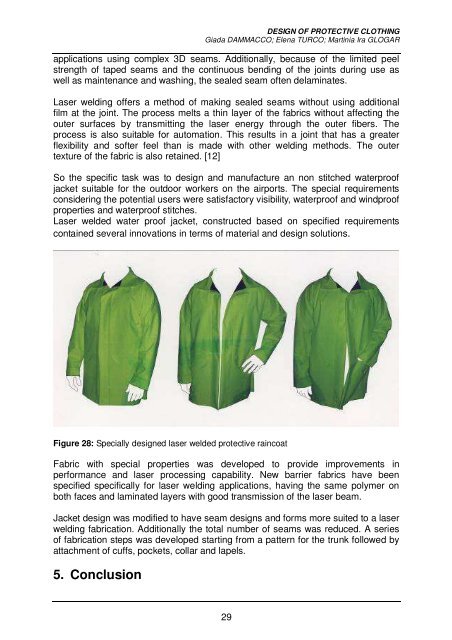Protective Clothing Design - Grado Zero Espace Srl
Protective Clothing Design - Grado Zero Espace Srl
Protective Clothing Design - Grado Zero Espace Srl
Create successful ePaper yourself
Turn your PDF publications into a flip-book with our unique Google optimized e-Paper software.
DESIGN OF PROTECTIVE CLOTHING<br />
Giada DAMMACCO; Elena TURCO; Martinia Ira GLOGAR<br />
applications using complex 3D seams. Additionally, because of the limited peel<br />
strength of taped seams and the continuous bending of the joints during use as<br />
well as maintenance and washing, the sealed seam often delaminates.<br />
Laser welding offers a method of making sealed seams without using additional<br />
film at the joint. The process melts a thin layer of the fabrics without affecting the<br />
outer surfaces by transmitting the laser energy through the outer fibers. The<br />
process is also suitable for automation. This results in a joint that has a greater<br />
flexibility and softer feel than is made with other welding methods. The outer<br />
texture of the fabric is also retained. [12]<br />
So the specific task was to design and manufacture an non stitched waterproof<br />
jacket suitable for the outdoor workers on the airports. The special requirements<br />
considering the potential users were satisfactory visibility, waterproof and windproof<br />
properties and waterproof stitches.<br />
Laser welded water proof jacket, constructed based on specified requirements<br />
contained several innovations in terms of material and design solutions.<br />
Figure 28: Specially designed laser welded protective raincoat<br />
Fabric with special properties was developed to provide improvements in<br />
performance and laser processing capability. New barrier fabrics have been<br />
specified specifically for laser welding applications, having the same polymer on<br />
both faces and laminated layers with good transmission of the laser beam.<br />
Jacket design was modified to have seam designs and forms more suited to a laser<br />
welding fabrication. Additionally the total number of seams was reduced. A series<br />
of fabrication steps was developed starting from a pattern for the trunk followed by<br />
attachment of cuffs, pockets, collar and lapels.<br />
5. Conclusion<br />
29
















